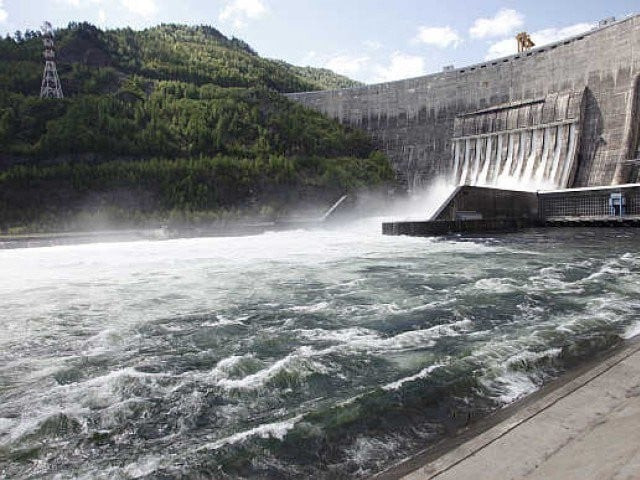The case for incentivizing hydropower development
Pakistan’s energy sector suffers from a high dependence on imported fuels

Pakistan’s energy sector suffers from a high dependence on imported fuels. PHOTO: REUTERS
Cost of generation
The cost at which the Government buys electricity from individual power projects is determined by NEPRA, as the independent regulator. The headline ‘tariff’ announced by NEPRA for a project uses the framework of ‘Levelized Cost of Energy’ (LCOE) – which one may assume is an ‘average’ rate that the Government must pay over the course of a multi-year concession. In fact, this is a rate calculated using a complex formula which does not reflect the actual cost that the Government must incur in each year of the relevant concession. As a result, an impression has been created that imported fuel projects have a lower cost of generation than hydropower projects. Those that are familiar with the LCOE framework, know that it penalizes high capex projects with low operating costs (e.g. hydropower) in favour of low capex projects that have a high cost of operation (e.g. thermal power).
To assess the greater benefits to consumers over the long run, one must look at the break up of these levelized tariffs that are awarded to investors. The RLNG plants commissioned in Pakistan were awarded a 25-year concession with levelized tariffs of 6.6 cents (variable - based on the cost of LNG over time). Pursuant to these tariffs, the Government would acquire power at 6.9 cents during the first 10 years, and 6.1 cents in the following 15-year period (when project debt would have been fully repaid). In comparison, a hydropower project operating under a 30-year concession with a similar levelized tariff of 6.6 cents would result in a cost of power to the Government of 8.5 cents during initial 10 years and only 3 cents in the ensuing 20-year period following settlement of project debt. Therefore, whilst the headline levelized tariffs are the same for both projects, the cost of one KWh every hour would be approximately $16,800 from RLNG versus $12,900 from hydropower. This is a 30% overpayment for RLNG without accounting for fluctuations in global LNG prices and the weakening of the Pakistan Rupee against the US Dollar which, as historical trends suggest, would make the equation even more favourable for hydropower. Over time, power generated from hydropower becomes cheaper whereas it either remains the same or, in most cases, becomes dearer for imported thermal power.
Imports, exchange rates & the economy
In addition to the cost of generation, Pakistan’s energy sector suffers from a high dependence on imported fuels. In pursing our short terms goals we have increased our reliance on imported fuels manifold in the past few years. Pakistan’s high import bills are the single biggest cause of the depreciation of our local currency. In this regard, hydropower has unique benefits on both the capex and opex fronts. Whilst hydropower is regularly maligned for the high capital expenditure required to install generation capacity, approximately 70% of the cost of construction of a hydropower plant is incurred on locally produced goods and services - such as cement, steel and labour. This is unlike other sources of power where approximately 80% of the cost is spent on importing goods and machinery. The money spent on cement, steel and labour is fed back into the Pakistani economy, usually in underdeveloped parts of the country, which acts as a further catalyst for Pakistan’s economic development – in particular, and very importantly, for the creation of both direct and indirect local jobs. On the opex side, once a hydropower plant is constructed, it will run on indigenous resources and has no ongoing fuel cost. As a result, the major portion of the awarded tariff will remain stable in Pakistan Rupee terms and decrease in USD terms. In contrast, the RLNG tariff will end up costing more in Pakistan Rupee terms over time as fuel must be constantly imported in USD to keep these plants in operation.
Thinking about the long term – asset creation and circular debt
Unlike any other form of power project open for investment in Pakistan, hydropower projects are being offered to investors under a Build, Own, Operate, Transfer (BOOT) model. Hydropower projects have a minimum design life of 50 to 70 years. In practice, this means that after 30 years the ownership of these projects will transfer to the Government of Pakistan free of cost. This represents real long-term asset creation for the Government and should alone be enough to justify a completely different incentive framework and mechanism for determination of tariffs for these projects. Once under Government ownership, the Government can either elect to further privatize these assets to generate immediate funds or choose to benefit from effectively free cost of electricity from these projects - approximately 1 cent per KWh that is needed in respect of operations and maintenance costs. Such ‘free’ electricity in the long term prevents a ramping up of circular debt. There can be no better examples of this in practice than our older projects like Tarbela and Mangla which today are producing electricity at a negligible cost. In turn, these projects are subsidizing the circular debt problem being otherwise created by our reliance on imported fuels. Countries like Norway are still benefiting from hydropower projects that were built 120 years ago. There is no doubt that hydropower investments pay themselves off multiple times over the long run.
Renewable energy development in Pakistan
Unfortunately, the widespread development of Pakistan’s renewable energy sector has to date been stalled under various pretexts. Towards the end of its five year term, the previous Federal Government appeared to make a policy decision to only award new renewable energy concessions via competitive bidding. No policy was however promulgated in this regard nor was projects in-progress allowed to continue under the published and current policy. Leaving aside the negative impact this has had on investor confidence in this important sector, it appears that the new Government at the centre wishes to continue this policy and a new Renewable Energy Policy 2019 is due to be published in the near future.
Given the strategic importance of Pakistan’s hydropower resources, and the unique benefits their development will bring to Pakistan, I would argue that hydropower projects be treated differently to other renewable energy projects. Whilst competitive bidding may make sense for technologies such as solar and wind, it will most certainly lead to the premature death of the small/medium hydropower sector in Pakistan. There are very few variables one needs to consider while assessing the viability of a particular site for a solar or wind project. Taking solar as an example, one needs to assess the amount of solar irradiation available at a site, cost of land, and distance from the grid station. Solar irradiation figures are widely available, and professional assessments can be carried out at very low costs. In order to put up a competitive bid a developer need not spend a lot of time or place significant capital ‘at risk’. In contrast, each hydropower site is unique. The number of variables are many, including geological issues (such as rock formation), social issues (such as resettlements, or protected areas) or technical issues (such as the quantum of available water). In order to fully assess a project, detailed feasibility studies need to be conducted. While these are all costly and time-consuming activities, failing to carry them out properly will lead to uncertainty about the viability of the project and therefore a higher estimated cost to account for these uncertainties. It is said that every dollar spent on the feasibility stage of a hydropower project saves multiple dollars in the construction stage. It is highly unlikely that any investor will put this magnitude of resources at risk, simply for the opportunity to participate in a competitive bidding process.
Certainly for small to medium hydropower projects, where some of the common environmental and social impacts of big hydropower construction are largely mitigated, I would argue that a better approach is to announce an upfront tariff where the government can set the direction as to what price it finds economically viable (after taking into account the total cost of electricity over the life of the project, not just the LCOE) and allow the developers to find sites which fit within that price target. This is one of the most effective ways of increasing adoption of a source of power. A clear goal post (i.e. a fixed tariff) highly incentivizes developers to find ways to make projects viable. Such clarity, may just be the catalyst that the Pakistani small to medium hydropower sector needs, where over 30,000MW of undeveloped potential exists. Other countries in the region, including India, Sri Lanka, Laos and Vietnam have been able to mobilize local developers to develop numerous small to medium hydropower projects, whereas Pakistan is lagging behind.
Hydropower projects have long gestation periods before they come to fruition. Only investors and developers who take a long term view of an economy and a market will have the appetite to put significant capital at risk to turn these projects to reality. The more certainty that the Government can provide such investors the more likely it is that such assets are developed for the Government in the private sector. One of the most obvious ways for the Government to reduce the long term cost of power in Pakistan is to develop our hydropower assets on a war footing. Policies must be formulated to ensure this takes place.
-Ali Maskatiya is the CEO of Markhor Energy – an investor and developer of renewable and conventional power projects in Pakistan. He can be contacted on am@markhorenergy.com















COMMENTS
Comments are moderated and generally will be posted if they are on-topic and not abusive.
For more information, please see our Comments FAQ